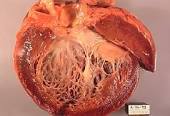
Diagnosed with Cancer? Your two greatest challenges are understanding cancer and understanding possible side effects from chemo and radiation. Knowledge is Power!
Learn about conventional, complementary, and integrative therapies.
Dealing with treatment side effects? Learn about evidence-based therapies to alleviate your symptoms.
Click the orange button to the right to learn more.
- You are here:
- Home »
- Blog »
- side effects ID and prevention »
- Trastuzumab-Induced Cardiomyopathy in Breast Cancer
Trastuzumab-Induced Cardiomyopathy in Breast Cancer

Trastuzumab-induced cardiomyopathy is a subset of one of the most serious short, long-term and late stage side effects of conventional cancer treatment. And that general side effect is called chemotherapy-induced cardiomyopathy (CIC). As a long-term cancer survivor who has also struggled with chemotherapy-induced cardiomyopathy since late 2010, I believe the crime here is that this side effect could be minimized and in many cases prevented all-together.
I maintain that cardiotoxic chemo and radiation cause heart damage that may never be identified. Or may show up decades later up as a late stage side effect. The point is that heart damage caused by conventional cancer therapies is more prevalent that the study linked below reports.
What are the possible adverse events of Trastuzumab (herceptin)?
- Cardiotoxicity: This is one of the most significant concerns with trastuzumab. It can lead to heart problems such as congestive heart failure, decreased heart function, and arrhythmias.
- Infusion reactions: Some patients may experience infusion-related reactions, which can include fever, chills, nausea, vomiting, headache, and allergic reactions such as rash or itching.
- Hypersensitivity reactions: Severe allergic reactions are rare but possible. Symptoms may include difficulty breathing, swelling of the face or throat, and severe itching.
- Pulmonary toxicity: Trastuzumab has been associated with pulmonary toxicity, including interstitial pneumonitis and pulmonary fibrosis, although this is rare.
- Neutropenia: A decrease in the number of neutrophils, a type of white blood cell, can occur, which may increase the risk of infections.
- Thrombocytopenia: A decrease in the number of platelets, which are important for blood clotting, can lead to an increased risk of bleeding.
- Hepatotoxicity: Rarely, trastuzumab can cause liver problems, including elevations in liver enzymes.
- Gastrointestinal disturbances: Some patients may experience diarrhea, nausea, vomiting, or abdominal pain.
- Fatigue: Feeling tired or weak is a common side effect of trastuzumab treatment.
- Musculoskeletal effects: Joint or muscle pain may occur in some patients.
After experiencing, researching and writing about the good, the bad and the ugly of both conventional and non-conventional cancer therapies, I have become more libertarian in my thinking when it comes to cancer patients and survivors. By this I mean that if the cancer patient fully understands the pros and cons of their therapies and still wants to proceed and take all risks of therapy, I believe the risk is up to the patient.
While oncology may say that everything they do is “shared decision-making” with the patient, I say hog-wash. Over the past decade, hundreds of cancer patients have told me that their oncologist stated that such and such was the next step in their therapy plan. No explanation of other possible therapies, no discussion of pros and cons of a specific therapy, nothing.
In the case of herceptin, the list of short, long-term and late stage side effects is long. And there are evidence-based non-conventional therapies shown to reduce or even prevent the cardiotoxicity that can result from it. See below.
But if a patient underwent heart healthy therapies, exercised, took regular saunas, etc. etc. then I’d say good luck to them. I don’t understand why oncology doesn’t do this for cancer patients undergoing cardotoxic therapies daily anyhow.
Are you considering Trastuzumab/hercepting therapy? Or have you already undergone herceptin and and want to prevent further damage to your heart? Maybe you have been diagnosed with Trastuzumab-induced cardiomyopathy and are hoping to manage it with both conventional and non-conventional therapies?
If you’d like to discuss cancer therapies, both conventional and non-conventional, email me at David.PeopleBeatingCancer@gmail.com
Good luck,
David Emerson
- Cancer Survivor
- Cancer Coach
- Director PeopleBeatingCancer
From 60% to 5% in 12 Weeks: A Trastuzumab-Induced Left Ventricular Ejection Fraction Drop
“However, trastuzumab is associated with cardiotoxicity. It manifests with an asymptomatic reduction of left ventricular ejection fraction (LVEF) and is reversible after discontinuation. Trastuzumab-induced new-onset acute decompensated heart failure is rare (0.5%)…
We report a case of a 54-year-old woman who received anthracycline (idarubicin, accumulated dose 400 mg/m2 doxorubicin equivalent) for her acute promyelocytic leukocyte 10 years ago, had no relevant comorbidities or other pre-existing cardiovascular diseases, had maintained normal cardiac function, presenting with new-onset dyspnea at rest and bilateral lower extremities swelling 12 weeks after receiving trastuzumab induction chemotherapy for her newly diagnosed early stage HER2-positive breast cancer…
This case report demonstrated a rare catastrophic cardiac toxicity effect of trastuzumab and its potential association with remote exposure to anthracycline. Studies have investigated the cardiotoxicity in the concurrent use of trastuzumab and anthracycline therapy.
However, how trastuzumab affected patients who were exposed to anthracycline for more than eight years had remained unreported. To our knowledge, no previous detailed case report has described the same clinical scenario as in this case…
In April 2012, a 44-year-old woman presented to the Kings County Hospital in Brooklyn complaining of sudden-onset left-hand weakness and unexplained ecchymoses. The patient was previously in good health with no comorbidities or taking any medications. A diagnosis of acute promyelocytic leukemia was confirmed by bone marrow biopsy. The patient received a PHEMA regimen (Tretinoin, Idarubicin, Mitoxantrone, and Mercaptopurine), which was completed in January 2015. Before and after the chemotherapy, the patient remained cardiac symptom-free...
Ten years later, in January 2022, the patient’s mammogram revealed two masses (1.2 cm & 0.6 cm) on the right breast. In March 2022, the patient underwent a breast lumpectomy and sentinel lymph node biopsy…
The cancer was staged clinically as stage IA (cT1c, cN0, cM0)…
The patient was first treated with paclitaxel (80 mg/m2) plus trastuzumab (2 mg/kg) every week for 12 cycles from June to September 2022, followed by four sessions of radiotherapy (total accumulated dose 5656cGy)…
Therefore, a diagnosis of trastuzumab-induced cardiomyopathy was made, and trastuzumab was discontinued…
Given the patient’s baseline soft blood pressure (systolic blood pressure around 90-100s), the patient was discharged with
- oral furosemide 40 mg daily for congestive heart failure (CHF) symptom control.
- Sacubitril/valsartan 24-26 mg twice daily,
- metoprolol succinate 50 mg daily, and
- dapagliflozin were also started per guideline-directed medical therapy (GDMT).
- Spironolactone was added in an outpatient follow-up visit in February 2023. Attempts were made to increase sacubitril/valsartan to 49/51 mg twice daily in February and March. However, the patient could not tolerate it and developed symptomatic hypotension.
Over a six-month interval follow-up, the patient reported that symptoms had improved gradually. By March 2023, the patient reported dyspnea after walking one block and intermittent lower extremities swelling. By July 2023, the patient was able to walk two to three blocks without dyspnea and denied orthopnea or lower extremities swelling. Repeated TTE in February 2023 showed severe diffuse left ventricular hypokinesis with LVEF of 10%, and another one in July 2023 showed severe diffuse left ventricular hypokinesis with mildly right ventricular hypokinesis, LVEF of 33%. Figure 4 shows the LVEF timeline for the patient. Given the patient’s ongoing LVEF <35% with New York Heart Association (NYHA) II symptoms despite maximally tolerated GDMT, the patient was referred to an advanced heart failure clinic…
It’s worth noting that radiation therapy-induced cardiomyopathy (caused by chemo toxicity) was a possibility in our patient. However, there is usually a long delay between radiation exposure and clinical manifestation, and radiation-induced cardiotoxicity is more commonly present as pericardial disease or diastolic dysfunction [5].
Receiving right-side breast radiation therapy, developing symptoms shortly after radiation therapy(within two months), absence of valvular or pericardium changes, and normal diastolic function all made radiation therapy-induced cardiotoxicity less likely. Therefore, our presumed diagnosis was trastuzumab-induced cardiomyopathy in the setting of previous idarubicin exposure 10 years ago…


